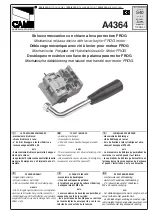
2
WARNING FOR CALIFORNIA RESIDENTS!
State of California Proposition 65 requires that we include the following warning:
This product contains a chemical known to the State of California to cause cancer and birth defects or other reproductive harm.
Important Cord Information
This appliance has a polarized plug (one blade is wider than the other). To reduce the risk of electric shock, this plug is intended to fit
into a polarized outlet only one way. If the plug does not fit fully into the outlet, reverse the plug. If it still does not fit, contact a qualified
electrician. Do not attempt to modify the plug in any way.
A short power supply cord is provided to reduce the risk resulting from becoming entangled in or tripping over a longer cord. An extension
cord may be used if care is properly exercised in its use. If an extension cord is used, the marked electrical rating of the extension cord
should be at least as great as the electrical rating of the appliance. The extension cord should be arranged so that it will not drape over
the countertop or tabletop where it can be pulled on by children or tripped over unintentionally.
Connect the power supply cord to a 120VAC electrical outlet only.
Getting Acquainted
Your Presto
Professional EverSharp
electric knife sharpener is a three-stage sharpening
system which will sharpen knives of alloy, carbon, or stainless steel. It is designed to
sharpen kitchen knives and most sporting knives.
Do not attempt to sharpen scissors, serrated electric knives, or any blade that does
not fit freely in the blade guides.
If your knife is very dull, you will probably use all three stages. If a bit dull, use Stages
2 and 3. Frequently, you will use only Stage 3 to maintain your knives in razor-sharp
condition. The blade selector (Fig. A) adjusts the guides to an optimum sharpening angle
for thick, medium, and thin knives.
How to Use
1. Place the knife sharpener on a stable surface.
2. Determine the type of knife being sharpened and then move the blade selector to the appropriate position (Fig. A).
For thick knives, such as hunting knives and cleavers, move the blade selector to the top position.
For medium knives, such as utility, slicing, chef’s, and Santoku knives, move the blade selector to the middle position.
For thin knives, such as fillet, paring knives, and other light blades, move the blade selector to the bottom position.
You will feel the stop points for each position. When you move the blade selector lever, the orange adjustable blade guides in Stages
2 and 3 will also move so they are at the optimum sharpening angle for the type of blade selected. In Stage 1, the blade guides are in
a fixed position.
3. Turn the unit ON by pressing the symbol “
l
” on the ON/OFF switch (Fig. A).
4. Evaluate the condition of your blade to determine with which sharpening stage to start:
• If the blade is very dull, or if you are sharpening the knife for the first time, begin with STAGE 1: COARSE GRINDING.
This is the stage located to the left of the ON/OFF switch. It is the coarsest and most aggressive stage, and will remove more
material from the knife blade than the other stages. It is a fixed stage with no adjustments, as it places the same angle on all blades
in preparation for the sharpening stations found in Stages 2 and 3.
Note:
Do not use Stage 1 when sharpening serrated blades.
• If your knife is a bit dull, begin with STAGE 2: PRECISION GRINDING.
This is the stage located directly to the right of the blade selector. It continues the grinding by giving the blade a precision edge. It
is an adjustable station, further refining the sharpening angle so that when you are done, your knife is sharpened to the optimum
angle dictated by the width of the blade.
• If your knife just needs a little touch-up sharpening, begin with STAGE 3: FINE HONING.
This is the stage located on the far right and is the stage most frequently used. It is also an adjustable station, completing the knife
sharpening process by honing and polishing the knife to an exact razor-sharp edge.
5. Begin sharpening. The sharpening procedure is the same for each stage.
Stage 1
Coarse Grinding
ON/OFF
switch
Fig. A
Stage 2
Precision
Grinding
Stage 3
Fine
Honing
Blade selector






















